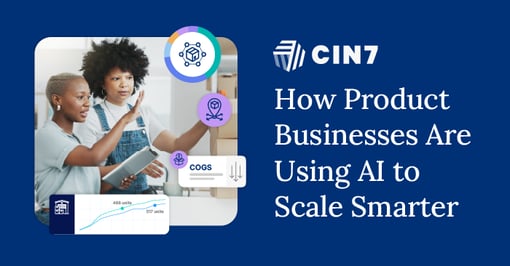
When it comes to artificial intelligence (AI), there’s no putting the genie back in the bottle. AI, whether you consider it a buzzword or a business booster, is here, and many product businesses are taking advantage of this advanced technology with the goal of transforming their operations.
And it’s working.
Cin7 spoke with 530 professionals within the inventory and supply chain industries about their thoughts on and experience with AI and automation. Their eye-opening responses, which we fully catalogue in our 2025 State of Inventory Intelligence eBook, confirmed what we already know: adopting AI to manage your inventory is no longer optional but a necessity for any business looking to succeed in today’s digital world.
Not convinced? We understand!
Implementing AI and automation isn’t just a matter of flipping a switch and off you go. Finding, purchasing, and deploying new technology takes time and money, but here’s the kicker (in a good way): it’s all worth it!
Tapping AI and Automation for Growth
According to 73% of the inventory pros we surveyed across the globe, growing their businesses is the primary goal for the next year. This is despite the fact that they face numerous challenges, like paying high operational costs, keeping up with customer demand, and feeling the squeeze during shopping holidays.
You know all about these issues, just like you know the challenge of syncing inventory across disconnected systems and channels. But what you may not know is that syncing this siloed information requires businesses to invest 16 hours a week and a whopping $21,632 annually for each entry-level employee required to do the job.
That’s no chump change!
On top of these budget-breaking, headache-inducing issues, supply chain disruptions, outdated inventory systems, unintegrated inventory and e-commerce platforms, and a lack of funding make a mockery of their (and your) ability to scale operations. That’s why many of your competitors are looking to AI and automation technologies for help.
Businesses are finding that eliminating their slow, expensive, and error-prone manual processes and replacing aging solutions with AI and automation is helping them scale. Specifically, they’re responding faster to customer demand and identifying slow-moving inventory or declining customer segments early. They’re also reducing their need to increase their employee headcount even as their complexity increases.
And you know what these jaw-dropping benefits have led to? A firm belief by 83% of these businesses that AI will lead to revenue growth.
That many businesses can’t be wrong, can they? We don’t think so.
AI Use Cases Delivering Results Now (Not Later)
So, how many inventory teams around the world are actually adopting these technologies and which technologies exactly? Per our research:
- 59% are all in with automation
- 39% are embracing AI
- 35% are adopting forward-thinking technologies (e.g., predictive analytics)
Digging deeper, we discovered that those who have adopted these technologies are strategically transforming how they do inventory management. How? By using AI to aid them in:
- Intelligent product segmentation (64%)
- Automating replenishment (56%)
- Multi-location planning (57%)
The return on investment (ROI) for these businesses (and for you, too, if you jump on board) is tangible. According to our research, “85% say it improves real-time visibility, 79% say it reduces operational costs, 78% report fewer stockouts, 75% say they experience less overstock,” and more. The more includes incredible time savings, up to an average of 15 hours per week!
You can see that hesitating to invest in advanced technologies puts your business at risk of falling to the wayside. But the million dollar question is, why aren’t you feeling the AI and automation love in the first place?
No AI Love: Barriers to Adoption
Like you, many teams are stuck in the “AI-curious” (what can it do for me?) phase. Forty-three percent of the pros we talked to are still not ready to implement the smart, but let’s admit it, disruptive technology.
However, there’s good news. Forty-seven percent want automation, 43% want to implement AI, and 35% want forward-thinking tech, with supply chain and logistics teams especially eager to adopt.
Wanting is half the battle! Even so, let’s look at why you and your fellow hesitators are holding back.
The top reason many can’t move forward with AI adoption is a lack of knowledge. One in five respondents told us they don’t really know the difference between AI and automation, while 60% weren’t sure which tools to choose. There were also budget concerns (44%) and a lack of leadership support (35%) putting a wrench in the potential plans.
Our global survey additionally revealed that product sellers like yourself don’t really trust AI—not with finance data (47%), nor with customer data (43%), and as for accuracy? Thirty percent said no way.
Sound or feel familiar? If so (and we don’t mean to add any pressure here), you should know that there’s a cost to waiting
The Risk of Delaying
Honestly? We understand why you’re delaying AI and automation adoption. Unfortunately, these concerns and your subsequent hesitation are allowing the early adopters (U.S. adoption is accelerating, and U.K. teams are lagging) to leap ahead.
Not only are the early birds gaining back 15 hours weekly through automation, but they’re also saving money, driving revenue, and increasing scalability. As their competitive advantage grows, yours decreases. Basically, this means the longer you wait, the harder it will be to catch up. Or maybe not catch up at all.
Remember Blockbuster? According to Charles Gaudet, CEO of Predictable Profits, Blockbuster went belly up because the company didn’t see the need for disruptive technology (e.g., streaming capabilities). Its main competitor, Netflix, did.
“Blockbuster failed because the leaders at the company couldn’t make the hard choices,” Gaudet writes. “They wanted to stick with ‘business as usual,’ rather than outpacing the innovators that snapped at their heels. Over time, this led to their competitive advantage slipping away.”
We don’t want that to happen to you (and you don’t want to be labeled the next Blockbuster), so let’s look at how you can prepare your business for success over the next five years and beyond.
Preparing for the Future (It Comes at You Fast)
Of the over 500 people we talked to, 87% believe AI will revolutionize inventory management over the next five years. Revolutionize means radical change, and, as we’ve been discussing, not all businesses are ready for it.
But you can be. Here’s how.
First, get your leadership team on board. You’ll need their emotional and financial support if you want to get any technology program off the ground. They’ll also be instrumental in ensuring your team gets the training needed to use the new inventory management tools the right way and to build a culture of trust and data accuracy (this is critical—don’t skip this step!) within your organization.
Next, you’ll want to choose an AI solution with clear integrations and reporting capabilities. AI should not be a bolt-on tool but one that’s integrated into the core of your inventory system. The system should also be able to combine AI with predictive analytics so that you can forecast demand months ahead.
Once you find the solution that’s right for you, enable the AI features and focus on one problem first, such as automated replenishment. After figuring that one out, expand to the next thing and then the next.
Finally, you’ll want to measure your success. This should include tracking time saved, reduced errors, and improved visibility. We’re confident you’ll see and feel the improvements right away!
AI Isn’t Coming—It’s Here
Thanks to businesses like Blockbuster, you know what not to do if you want to become a leading, successful product business and that’s doing nothing. You must overcome your fears of innovative technology, and you never know, if you do, you, not your competitors, might be the one setting the pace five years from now.
Are you ready to take the journey from manual to automated systems? Cin7 offers incomparable cloud-based inventory management software with AI-powered forecasting capabilities that deliver an automated inventory experience.
“We save two-to-three work days, which is about 16-to-24 hours of manual labor. We don’t have to manually upload and sync inventory or upload orders one-by-one, like we did with Fishbowl,” says Cin7 customer Ashely Gilbert, head of operations and business development for The Lip Bar.
“Automations with Cin7 are huge and super helpful,” she adds. “They can’t be underestimated or undervalued.”
We invite you to contact us for a free demo to see for yourself how we can be your forward-thinking partner, helping you embrace AI and automation so that you can sell more, save time, and scale smarter!
More from the blog
View All Posts
The Cin7 Summit 2025 Lookback
Read More
How Blockchain Is Revolutionizing Supply Chain Management
Read More




